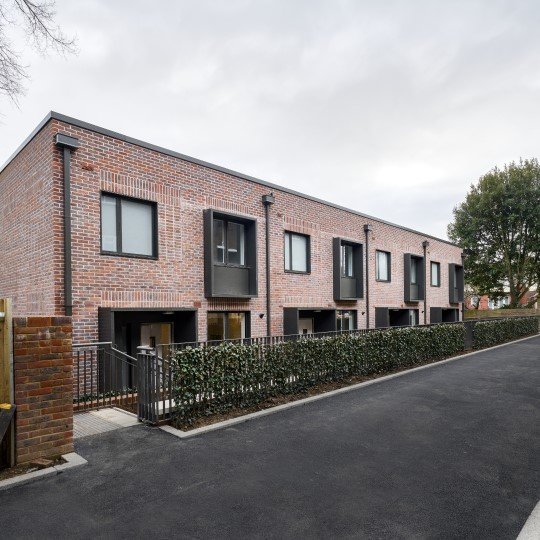on this page
-
Markets
Buildings & places

Simon Peevers
Senior Advisor External Communications, Bristol, United Kingdom contact form+44 1454 667 587
The government’s pledge to build 1.5 million homes during this Parliament is a mandate to fundamentally change how we plan and deliver much-neeed new housing in the UK. But hitting that target means building an average of 350,000 homes a year, a marked step-up of 35%-40% from current levels. So, the question we posed at the London Real Estate Forum (LREF) in September, was how can we achieve that?
Here, Rosie Andrews, AtkinsRéalis' National Client Engagement Lead Buildings & Places - Property, explains how we put the challenge to roundtables of planners, developers, funders, local government and authorities, designers and more.
Making planning deliverable, not debatable
“Give us capacity and clarity, and you’ll get pace.” - roundtable participant
The conversation was noisy, hopeful, occasionally exasperated but remarkably aligned on the practical moves that will turn plans into action. The key themes of capacity, consistency and clarity kept coming through many of the discussions. We heard that planning teams are working hard, but the pipeline we want requires more hands, steadier guidance on what ‘good’ looks like, and proportionate, risk-based routes through all stages, including building-safety gateways so projects aren’t redesigned mid-flight.
Infrastructure has to be at the planning table from day one, that was clear. We heard that many sound schemes are undone due to constraints in power supply, water, access and enabling works. Aligning spatial planning with utilities planning including early load assessments, clear connection timelines, transparent queues, enables design for reality, not optimism.
Several tables also argued for more national consistency on defined classes of development; others stressed preserving local discretion where character matters. The common ground was predictability: fewer surprises, more pre-agreed standards, and early utilities sign-off that sticks.
Close the affordability and viability gap
“We’re not short of sites, we’re short of investable propositions.” - roundtable participant
If planning unlocks time, viability unlocks funding. With costs high, values uneven, and the economic case rapidly evolving, too many consented schemes don’t stack when shovels are ready – according to some of our discussions.
The fixes are pragmatic. Patient capital and targeted gap-funding can tip marginal projects over the line if the triggers are rules-based and transparent, not discretionary. Risk-share needs to be explicit and priceable; enabling infrastructure and policy-risk sit where they’re best managed, delivery performance, quality and lifecycle costs sit where they can be controlled. The numbers don’t work at scale without a confident affordable housing pipeline, with clear grant rules, stable rent policy, and tenure mixes that reflect local need.
Confidence also comes from pipeline visibility. Manufacturers, developers and lenders invest when they can see beyond the one-off. Publishing multi-year, regionally phased pipelines, with agreed typologies (especially for mid-rise and small sites), gives factories and funders the signal to scale. And because infrastructure can dwarf on-plot costs, front-loading enabling works is crucial. When those works unlock more than one site, treat them as public goods.
There’s also a near-term pressure valve in conversion and reuse. It isn’t a silver bullet, but where the fabric allows, it delivers faster, with lower carbon and often lighter infrastructure demands than new-builds.
Build like we mean it
“Small sites are a big opportunity. Clear templates for the repeatable stuff would let firms deliver in dozens, not ones and twos.” - roundtable participant
Pace requires above all a steady programme. The delivery discussion converged on industrialised construction: standardised components, repeatable details and digitally coordinated supply chains that compress time while lifting quality. The point is not to stifle design, it’s to standardise elements like cores, MEP risers, wet rooms, façade systems, so teams stop relearning the same lessons, while keeping flexibility where it creates value.
Factory schedules slip when logistics are an afterthought: crane locations, road space, utilities corridors, delivery windows. Plan them early and collaboratively, within an alliance model where possible, and manufacture-to-assembly flow follows on site. And none of this works without competency: apprenticeships and upskilling aligned to industrialised methods and the safety regime.
We can see where this works most effectively with the work of AtkinsRéalis' social and affordable housing developer EDAROTH, which has honed an approach to housing based on industrialised manufacturing which has gone live across a number of UK sites this year.
Innovate to accelerate
“If ever there was a time to be innovative, this is it.“ - roundtable participant
The session produced no shortage of fresh thinking. Ideas ranged from clearer routes to market with pre-approved detail libraries, standard product sets, and regulatory sandboxes for modern methods and multi-tenure schemes, to new models of working, such as alliancing that shares risk and reward while keeping outcomes in focus.
Participants also pointed to bolder local government, curating renovation at scale and shaping private capital rather than regulating it. And, where speed outweighs discretion, some argued for centralising specific decisions to give consistency across asset classes.
Change the tempo, not the tone
What stood out for me across the day was how much common ground there was. Across all the roundtables the same themes recurred and three clear asks were made:
- Resource planning and utilities upfront. Expand local capacity and bake in utilities from the first sketch, with proportionate, risk-based routes through safety and consent.
- De-risk the capital stack. Patient capital, gap-funding and honest risk-share—especially on enabling infrastructure—so marginal schemes become investable.
- Industrialise delivery. Standardise components, publish pipelines and align skills to methods so productivity compacts time without trading off quality.
These are ideas which will sound familiar across the sector, but what is new is doing them together, consistently, at scale, in partnerships founded on trust and knowledge-sharing.
Across the tables, the strongest consensus was simple: trust. Create predictable pathways and dependable partnerships, keep outcomes for people front and centre, and we can build well and build now.
Change doesn’t happen overnight and this is a complex sector. But those 240 people around the LREF tables proved that we’re not short of excellent ideas to turn problems into solutions, slogans into programmes, and plans into action.
Please note that you are now leaving the AtkinsRéalis website (legal name: AtkinsRéalis Group inc.) and entering a website maintained by a third party (the "External Website") and that you do so at your own risk.
AtkinsRéalis has no control over the External Website, any data or other content contained therein or any additional linked websites. The link to the External Website is provided for convenience purposes only. By clicking "Accept" you acknowledge and agree that AtkinsRéalis is not responsible, and does not accept or assume any responsibility or liability whatsoever for the data protection policy, the content, the data or the technical operation of the External Website and/or any linked websites and that AtkinsRéalis is not liable for the terms and conditions (or terms of use) of the External Website. Further, you acknowledge and agree that you assume all risks resulting from entering and/or using the External Website and/or any linked websites.
BY ENTERING THE EXTERNAL WEBSITE, YOU ALSO ACKNOWLEDGE AND AGREE THAT YOU COMPLETELY AND IRREVOCABLY WAIVE ANY AND ALL RIGHTS AND CLAIMS AGAINST ATKINSRÉALIS, AND RELEASE, DISCHARGE, INDEMNIFY AND HOLD HARMLESS ATKINSRÉALIS, ITS OFFICERS, EMPLOYEES, DIRECTORS AND AGENTS FROM ANY AND ALL LIABILITY INCLUDING BUT NOT LIMITED TO LIABILITY FOR LOSS, DAMAGES, EXPENSES AND COSTS ARISING OUT OF OR IN CONNECTION WITH ENTERING AND/OR USING THE EXTERNAL WEBSITE AND/OR ANY LINKED WEBSITES AND ANY DATA AND/OR CONTENT CONTAINED THEREIN.
Such waiver and release specifically includes, without limitation, any and all rights and claims pertaining to reliance on the data or content of the External Website, or claims pertaining to the processing of personal data, including but not limited to any rights under any applicable data protection statute. You also recognize by clicking “Accept” that the terms of this disclaimer are reasonable.
The information provided by Virtua Research cited herein is provided “as is” and “as available” without warranty of any kind. Use of any Virtua Research data is at a user’s own risk and Virtua Research disclaims any liability for use of the Virtua Research data. Although the information is obtained or compiled from reliable sources Virtua Research neither can nor does guarantee or make any representation or warranty, either express or implied, as to the accuracy, validity, sequence, timeliness, completeness or continued availability of any information or data, including third-party content, made available herein. In no event shall Virtua Research be liable for any decision made or action or inaction taken in reliance on any information or data, including third-party content. Virtua Research further explicitly disclaims, to the fullest extent permitted by applicable law, any warranty of any kind, whether express or implied, including warranties of merchantability, fitness for a particular purpose and non-infringement.
The consensus estimate provided by Virtua Research is based on estimates, forecasts and predictions made by third party financial analysts, as described above. It is not prepared based on information provided by AtkinsRéalis and can only be seen as a consensus view on AtkinsRéalis' possible future results from an outside perspective. AtkinsRéalis has not provided input on these forecasts, except by referring to past publicly disclosed information. AtkinsRéalis does not accept any responsibility for the quality or accuracy of any individual or average of forecasts or estimates. This web page contains forward-looking statements based on current assumptions and forecasts made by third parties. Various known and unknown risks, uncertainties and other factors could lead to material differences between AtkinsRéalis' actual future results, financial situation, development or performance, and the estimates given here.
Downloads
Trade releases

